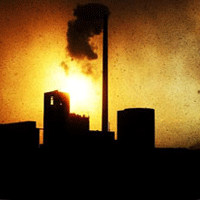Indian factory activity shrank for the first time in more than four years last month, adding to the country's deepening economic malaise even as the Reserve Bank of India (RBI) struggles to defend the battered rupee currency, a survey showed.
The bleak Purchasing Managers' Index (PMI) comes hard on the heels of data on Friday that showed Asia's third-largest economy grew at it slowest quarterly rate in the three months to June since the global financial crisis, suggesting more pain ahead.
The HSBC Manufacturing PMI, compiled by Markit, sank to 48.5 in August from 50.1 in July, the lowest reading since March 2009. Economists polled by Reuters had expected a far shallower fall to 49.9.
The index, which gauges business activity in Indian factories but not utilities, had been close to the 50 mark that separates growth from contraction since May but falling orders dragged it under last month.
"Manufacturing activity contracted in August for the first time since March 2009. This was led by a decline in new orders, especially export orders," said Leif Eskesen, chief economist for India at survey sponsor HSBC.
The survey showed new export orders shrank for the first time in a year.
In a sign that domestic demand is also faltering, new orders, which include domestic orders, shrank at a faster pace. The index fell for the sixth straight month to 47.5 in August, its lowest since February 2009.
That prompted factories to cut production, with the sub-index measuring output falling to its lowest since early 2009.
Data on Friday showed the Indian economy grew 4.4 per cent in the April-June quarter, the slowest quarterly rate since Jan-March of 2009, hurt by a contraction in mining and manufacturing.
Indian economic growth has nearly halved in the last two years to a decade-low rate of 5 per cent in the fiscal year that ended in March, and a majority of the economists surveyed by Reuters last week expect this year to be worse.
Weighed down by a record current account deficit, the Indian rupee has lost around a fifth of its value since the U.S. Federal Reserve hinted in May it was going to start paring back its stimulus, sparking capital outflows from many emerging markets.
The beleaguered rupee suffered its worst month ever in August, hitting successive record lows, leaving the Reserve Bank of India few options to support the economy.
The RBI's main defence of the rupee has rested on draining cash from domestic money markets and raising short-term interest rates, making loans to struggling businesses costlier and adding to growth concerns.
"The RBI will likely keep its liquidity tightening measures in place for a while still to help contain the depreciation of the currency," Eskesen added.
"Combined with the heightened macroeconomic uncertainty, this will continue to weigh on growth in coming months."
Raghuram Rajan, former chief economist at the International Monetary Fund, is set to take over as governor of the Reserve Bank of India this week. Economists in a separate Reuters poll said his immediate focus will be to bolster the currency.
China’s factory activity up for first time in 4 months
China's factory activity expanded for the first time in four months in August as domestic demand rebounded, a private survey showed on Monday, the latest sign that the world's second-largest economy may have avoided a sharp slowdown.
The final Markit/HSBC Purchasing Managers' Index (PMI) climbed to 50.1 in August, up sharply from July's 47.7 and in line with last week's flash preliminary reading.
The survey came a day after China's official manufacturing PMI showed factory activity expanded at the fastest pace in more than a year in August with a jump in new orders.
Economists cheered the upbeat data as a sign that China's economy, which has cooled in 12 of the last 14 quarters, is finally steadying.
"We are definitely stabilising, but it's going to be a pretty weak to flat recovery," said Stephen Green, an economist at Standard Chartered.
Asian shares climbed to a two-week high and the Australian dollar and copper gained after the report.
Modest growth in China's factories should still comfort financial markets, however, offering hope that a run of encouraging data in July was not a fluke.
The official PMI, which came in at 51.0 versus expectations for 50.6, is more weighted towards bigger and state-owned firms, which have easier access to credit and the scale to cope better with downturns than the smaller private firms that form the backbone of the Markit/HSBC survey.
As recently as a month ago, investors had worried that China's economy was slipping into a deeper-than-expected downturn, especially after its money market was hit by an unprecedented cash crunch in June.
But policymakers have stepped in with a series of measures aimed at stabilising the economy, including quickening railway investment and public housing construction and introducing policies to help smaller companies with financing needs.
Exports still weak
Senior officials have also been talking up the economy, saying there are clear signs of stabilisation emerging and that the government's annual GDP target of 7.5 per cent is achievable.
Data for July had showed a pickup in trade and industrial output, while foreign investment into China also quickened, adding to confidence in the economy.
"We expect some upside surprises to China's growth in the coming months," said Qu Hongbin, an HSBC economist, noting that factory activity had picked up on firms rebuilding their stocks and on recent steps taken by authorities to boost activity.
However, any expectations for a strong rebound may be misplaced. As a PMI reading above 50 indicates growth while one below 50 demarcates contraction, the latest Markit/HSBC data suggests August's expansion was only modest.
Indeed, the survey showed new export orders dipping from July to stay well below the 50-point threshold. New orders, which include domestic orders, showed marginal growth by rising to 50.8, albeit a four-month high.
HSBC said lethargic export sales remained an Achilles' heel for China, with factories citing weak U.S. and European demand behind last month's fall in overseas orders.
Other downside factors linger, too. For example, most Chinese firms still face relatively high financing costs, in part due to Beijing's campaign to curb shadow banking. A strong yuan currency is also dampening the trade picture.
Major Chinese retailers are also more downbeat that official figures might suggest.
A Reuters review of first-half earnings showed that more than 20 Chinese companies selling everything from footwear to food were not convinced the economic slowdown had bottomed out, and neither were their traditionally thrifty customers.
Also a concern is that average input costs rose in August for the first time since February on the back of higher raw material prices, HSBC said.
At the same time, slowing growth has put pressure on China's heavily indebted companies and provincial governments, raising concerns that the country's explosion in credit since 2008 could be on the verge of a meltdown.






